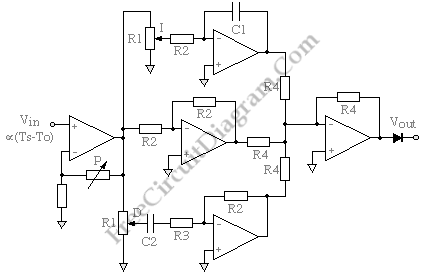Analog PID Controller

The circuit diagram below shows us about a form of PID controller. The input signal is buffered and amplified by a non-inverting amplifier and the gain of this stage defines the proportional gain P of the controller.The amplified error signal passes in parallel through an integrator (top) a unity-gain amplifier (middle) and a differentiator (bottom) all of which have inverting behaviour. The final op-amp sum and invert the outputs and passed to the output. The potentiometers labeled D and I control the proportions in which derivative and integral fractions contribute to the output signal which is proportional to the power W to be supplied to the heater.
It is most likely to be troublesome by causing an offset between the set-point and oven temperatures. Under some circumstances the integrator may drift and eventually saturate which would prevent it from working properly. To reduce the impact of op-amp offset and bias, the first thing to try would be a resistor, equal in value to R2, between the positive input of the integrating op-amp and ground to eliminate the common-mode bias current. Selecting an op-amp with a good input-offset performance would be the next step.